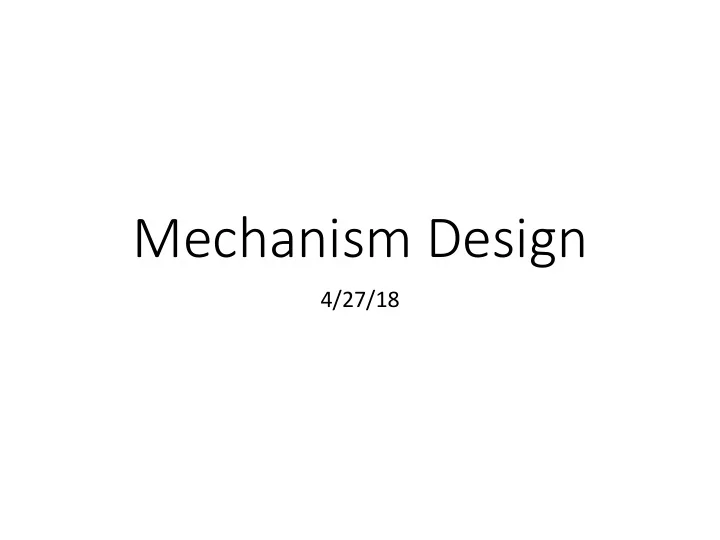

Mechanism Design 4/27/18
Game-Theoretic Modeling • Determine what actions agents could take. • Determine the agents’ incentives: Assign a utility for each agent to every outcome. • Compute Nash equilibria to predict how agents will behave.
Mechanism Design “Inverse game theory” Goal: get self-interested agents to achieve some outcome. • We get to design the rules of the interaction. • Agents will then behave strategically. • Try to ensure that the equilibria are good ones.
Mechanism Design Examples • Scheduling an event. • We want to find a time that’s most convenient for the participants. • Allocating a resource. • We want the agent that will benefit the most from the resource to receive it. • Job Matching. • We want to assign candidates to jobs so that both the workers and the companies are satisfied.
Obstacle: Private Information In all three examples, the agents have relevant information that we (the designer) are missing. • Scheduling: when they’re busy. • Allocation: how much they value the resource. • Matching: which jobs/candidates they like best. If we knew this information, we could compute the best solution. So let’s ask the agents to share.
Strategies in MD Settings Generally, the mechanism will ask agents about their preferences. • Scheduling: when are you free? • Allocation: how much is the resource worth to you? • Matching: rank the jobs / rank the candidates. Problem: what if they lie?
Dominant Strategies • A dominant strategy is one that is a best response to anything the other agents can do. Compare to dominated strategies (from Monday): • Stronger in one sense: a dominant strategy must always be at least as good as every other option . • Weaker in another sense: another strategy can sometimes be tied with the dominant strategy. Dominant strategies easy to understand and analyze. • Design goal: find a mechanism where every agent has a dominant strategy.
Truthfulness If the mechanism asks agents to reveal their preferences, we would like for them not to lie. A truthful mechanism is one where revealing their true preference is a dominant strategy for every agent. This means that a truthful mechanism has a unique Nash equilibrium in pure strategies, where every agent’s strategy is to reveal their true preferences.
Revelation Principle If there exists any dominant strategy mechanism, there exists a truthful mechanism that achieves the same outcome.
Scheduling • Are doodle polls truthful? Is there incentive to lie? • The only truthful mechanism is a dictatorship. • Note: CS course lotteries aren’t a dictatorship.
Resource Allocation We can incentivize truthful reporting with money. Sealed-bid auctions: • Agents submit how much they are willing to pay. • First-price rule: highest bidder gets the resource and pays what they bid. No! • Is it truthful? • Second-price rule: highest bidder gets the resource and pays the 2 nd highest bid. • Is it truthful? Yes!
Matching Gale-Shapely mechanism: • Each round, each company makes one offer. • Candidates can conditionally accept or permanently reject. • Any company that got rejected makes a new offer in the next round. • Candidates that get a second offer must reject one. • Stop when all there are either zero unmatched companies or zero unmatched candidates. In algorithms we prove that this halts in linear time. Is it truthful?
A Shameless Plug If you find mechanism design problems like these interesting, there’s a class you should take. Algorithmic game theory next semester will go into way more depth on all of this week’s topics.
Recommend
More recommend